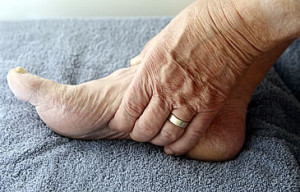 More than 8 million people in the U.S. suffer from chronic, or non-healing, wounds. While underlying causes of chronic wounds vary from patient to patient, they frequently occur in patients with diabetes, and often on the foot.
More than 8 million people in the U.S. suffer from chronic, or non-healing, wounds. While underlying causes of chronic wounds vary from patient to patient, they frequently occur in patients with diabetes, and often on the foot.
Approximately one in four people with diabetes will develop a foot ulcer in his or her lifetime, potentially causing infection, disability or possible amputation. Foot ulcers may form for a number of reasons, among them poor circulation, an irritation, lack of feeling in the foot and foot deformities.
When you have diabetes, proper foot care is very important. Poor foot care may lead to amputation of a foot or leg.
As a person with diabetes, you are more vulnerable to foot problems, because diabetes can damage your nerves and reduce blood flow to your feet. The American Diabetes Association estimates that one in five people with diabetes who seek hospital care do so for foot problems. By taking proper care of your feet, most serious health problems associated with diabetes can be prevented. Your doctor will check your feet each year for any problems.
Neuropathy is another factor that can put people with diabetes at a higher risk for foot ulcers. Resulting from elevated glucose levels over a long period of time, neuropathy causes lost or reduced feeling in the feet. If you have diabetes, talk with your physician about being tested for neuropathy during your regular visits.
Wash and Dry Your Feet Daily
- Use mild soaps
- Use warm water
- Pat your skin dry; do not rub. Thoroughly dry your feet.
- After washing, use lotion on your feet to prevent cracking. Do not put lotion between your toes.
Examine Your Feet Each Day
- Check the tops and bottoms of your feet. Have someone else look at your feet if you cannot see them.
- Check for dry, cracked skin.
- Look for blisters, cuts, scratches, or other sores.
- Check for redness, increased warmth, or tenderness when touching any area of your feet.
- Check for ingrown toenails, corns, and calluses.
- If you get a blister or sore from your shoes, do not “pop” it. Apply a bandage and wear a different pair of shoes.
Take Care of Your Toenails
- Cut toenails after bathing, when they are soft.
- Cut toenails straight across and smooth with a nail file.
- Avoid cutting into the corners of toes.
- Do not cut cuticles.
- You may want a podiatrist (foot doctor) to cut your toenails.
Be Careful When Exercising
Protect Your Feet With Shoes and Socks
- Never go barefoot. Always protect your feet by wearing shoes or hard-soled slippers or footwear.
- Avoid shoes with high heels and pointed toes.
- Avoid shoes that expose your toes or heels (such as open-toed shoes or sandals). These types of shoes increase your risk for injury and potential infections.
- Try on new footwear with the type of socks you usually wear.
- Do not wear new shoes for more than an hour at a time.
- Change your socks daily.
- Look and feel inside your shoes before putting them on to make sure there are no foreign objects or rough areas.
- Avoid tight socks.
- Wear natural-fiber socks (cotton, wool, or a cotton-wool blend).
- Wear special shoes if your health care provider recommends them.
- Wear shoes/boots that will protect your feet from various weather conditions (cold, moisture, etc.).
- Make sure your shoes fit properly. If you have neuropathy (nerve damage), you may not notice that your shoes are too tight.

